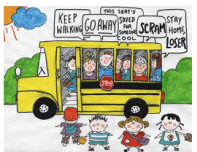Resources for Teachers

The Cool Bus, Anonymous
Stop School Bullying
The below is excerpted from Kalamazoo College’s website dedicated to creating Safe Learning environments for kids.
What can be done?
As teachers, it is important that we do not provide the conditions in which bullies and victims are able to manifest themselves. Easier said than done, right?
Things that we can do:
- Create a peer environment that sanctions against, rather than ignores or condones, the kinds of continuing hurtful actions that occur in bully/victim relationships.
- Take into account the fact that many factors help to maintain the bully/victim relationship, therefore the most successful interventions take place simultaneously at the individual, dyad, peer, classroom, school and family levels.
Suggestions for all teachers and administration:
Schedule a full staff meeting to raise awareness and knowledge.
- Find out what other schools have done
- Find out existing programs or initiatives in your school
Develop an anti-bullying school policy (see section below)
- Consultation between teachers, students, parents and other school personnel
- Backed up by curriculum work and existing policies
- Playground improvements
- Peer support services such as peer counseling.
- Increase adult supervision at key times (lunch, recess, etc.)
Create a short questionnaire or survey given to students and adults.
- Ascertain the level and nature of bully/victim problems in school
- Create awareness of extent of problem
- Discuss at staff meetings and with children and parents
Raise parental awareness.
- Parent-teacher conferences
- Parent newsletters
- PTA meetings
Explore possible SST (social skills training) programs.
- Develop empathy among all children
- Develop anger management skills for bullies
- Effective conflict-resolution skills for bullies
- Assertiveness training for victims
In the classroom.
- Classroom discussion – agree on classroom rules regarding bullying
- Role play exercises – how to assist victims, etc.
- Give clear message that bullying is not acceptable at school
- Consistently use agreed upon rules and punishment
- Encourage reporting of bullying
- Praise for avoidance of bullying
Excellent creative activities to raise awareness about bullying can be found at the Education World website.
Teach students this creed against bullying in your classroom (Olweus, 1993).
- We shall not bully other students
- We shall try to help students who are bullied
- We shall make a point to include students who are easily left out
Developing a school policy on bullying
Research shows that having a policy helps to combat bullying if:
- everyone knows what the policy is
- the policy is applied consistently
- everyone believes in the policy
Things to discuss in developing a policy:
- What counts as bullying in your school?
- What are the aims of your policy?
Think about:
- preventing bullying
- dealing with bullying if it occurs
- building on your school discipline policy
- fitting in with your social education policy
What will the policy consist of?
- raising awareness through the curriculum
- giving pupils opportunities to talk about bullying in general
- supervision of key areas of the school
- procedures for investigating incidents
- guidelines for listening to victims, witnesses and bullies
Who is going to do what?
- Can you identify specific responsibilities for specific people: teachers, pupils, parents, and staff?
- How are you going to communicate the policy to all concerned?
- How will people be encouraged to be committed to the policy?
- Can you involve the school board, teaching/non-teaching staff, pupils and others in discussions?
